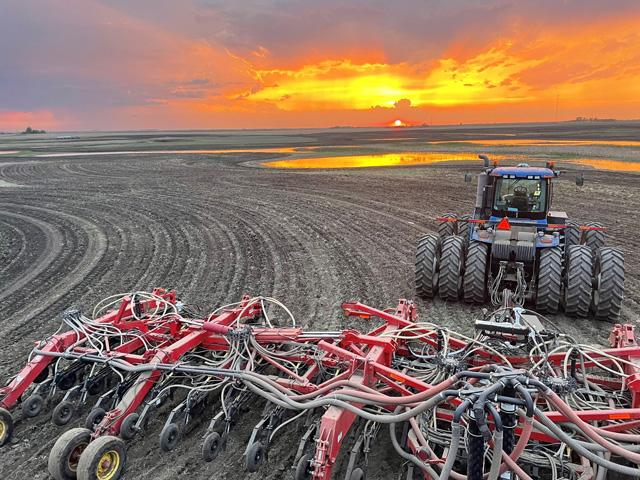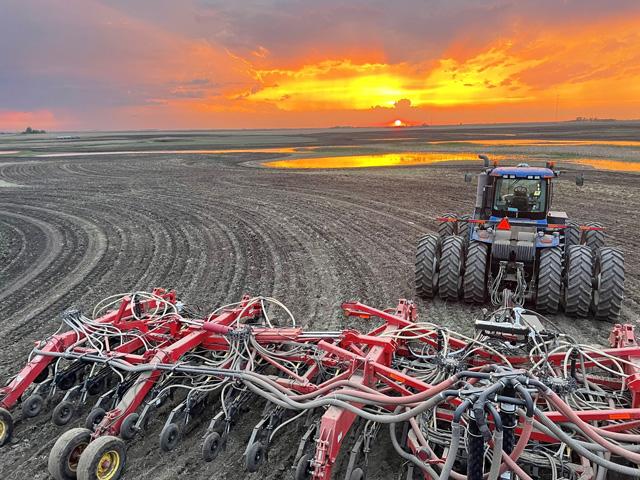Market Matters Blog
Did Wet Spring in Upper Midwest Cause More Prevented Planting Acres?
Heavy April snow in the Dakotas and northwest Minnesota left farmers wondering if and when they would get in their fields to start spring wheat and other small grains planting -- and if they would get their corn in ahead of the last insurance plant date.
Talk of prevented planting began to swirl as the melting snow added to the rise in the Red River of the North and small stream flooding that swamped some fields.
Prevented planting (PP) is failure to plant an insured crop with the proper equipment by the final planting date designated in an insurance policy's "special provisions" or during the late planting period, if applicable. Final planting dates and late planting periods vary by crop and by area, according to USDA Risk Management Agency (RMA).
For most of Minnesota, the final planting date for corn used for grain was May 31. For northern counties, it was May 25. Most of North and South Dakota final planting date for corn used for grain was May 25. Southern Minnesota and some counties in the eastern Dakotas had a May 31 final planting date.
Final planting dates for spring wheat in North Dakota are May 31 or June 5, depending on the county and is the same for most of Minnesota as well.
Once the final planting date arrives, farmers can file a claim if they can't plant because fields are too wet. Should they plant after the final planting date, the coverage drops 1% each day for the next 25 days, which is the end of the late period.
I reached out to several farmers and elevators on May 31 and asked about the status of their planting and if they would be able to get all their intended crops in. The comments were mixed, but more hopeful than what they told me when I talked to them on April 10.
Vance Johnson, Breckenridge, Minnesota, said, "Finished everything noon on Monday. No PP here. Just bring the rain now."
P[L1] D[0x0] M[300x250] OOP[F] ADUNIT[] T[]
"Planting is going well," said Matthew Krueger, East Grand Forks, North Dakota. "We should finish soybeans by Saturday and then we just have one day of sunflowers and that's it. We will have about 5% PP on our intended corn acres, but I know there will be some with more PP and others who thought they would have more, end up with much less."
Tim Dufault, Crookston, Minnesota, said, "I haven't heard a sound about PP in Minnesota. There might be a few tree rows that had snowbanks in them that made the field edge too wet to plant. But nothing worth turning in a claim for. Have not heard the PP cry yet from guys I checked with."
"We finished up the main run of spring wheat seeding on May 17 and went back and filled in a few wet spots after that, finished corn planting on May 25 and should get wrapped up on soybeans today (June 1)," said Ryan Wagner, Roslyn, South Dakota. "We will not have any PP here, which is hard to believe considering how things looked around here in late April with all the snow. The wheat and corn are up and look good, but we could use a shot of rain for the crops and also to active pre-emerge herbicides."
"We finished the last of our soybeans last Saturday! Everything seems to be emerging well, but a rain would be welcomed as a few seeds might be sitting in dry dirt," said Peter Bakkum. Mayville, North Dakota.
Kyle Schultz, Embden, North Dakota, said, "We are just about done. We ran very hard the last two weeks to get this far. There will be very little PP in our area this year and we are in a perennial wet area that usually has some PP. Last year's PP got seeded to winter grain crops that it looks like will be grown full term to harvest and not terminated for beans or corn. We will have 3% PP of our intended corn acreage that is along a major drain that has yet to completely quit running due to a large drainage basin. We did actually get our intended 1,000 acres of corn in by doing 30 more acres on another chunk, but that's all we had to leave that will not be planted to any crop. Overall, we are done ahead of average."
Stu Letcher, North Dakota Grain Dealers Association executive vice president, said, "I'd say we are actually ahead of last year in the central Red River Valley. Most of the guys I have talked to are either done or plan to be done with planting this week. As for PP acres I haven't heard any actual percentages yet. The final planting date for the southern Red River Valley is today (May 31)."
"We got 100% of intended acres in for corn, spring wheat and soybeans," said Darrin Schmidt, eastern North Dakota. "We still have edibles, pintos and navys going in, but it is getting dry here. Could use a rain."
Peter Ness, Sharon, North Dakota, said, "We finished last week. We had a good stretch of two weeks with no rain, so we got 99% in. Always have some sloughs and wet areas. Was able to get all the soybean and sunflower pre-emerge laid down in between the wind blowing. Now, we are just hoping for some much-needed moisture."
"Things are going well around here. Only have a few more days of seeding soybeans and that'll be a wrap for the season," said Kim Saueressig, McClusky, North Dakota. "Been a long finish; we've actually been getting some good shots of rain over the last couple of weeks that has been keeping us out of the fields. Won't really be any PP around here, only a few spots here and there that we had to go around but nothing to add up. Even talking with friends in eastern North Dakota, they are surprised at how fast the spring has been going and are now talking about how dry it is and that rain is going to be needed really soon. It's amazing what the heat and moisture can do for the crops. Trying to wrap up the pre-emerge spraying so we can get going on spraying in crop barley and durum. But there again we've been battling Mother Nature but not complaining about the rain. I'll never turn away a good rain!"
Jason Hanson, owner of Rock and Roll Agronomy LLC, Webster, North Dakota, said, "I can't believe there is going to be much if any PP at all. We need a rain BAD. I have not heard the PP mention from folks in my area. Ten days of strong winds and mid-80s have us dry."
"Certainly not as much PP as we thought about 10 days ago. The warmer temps and wind have really dried out the ground so they can plant," said Keith Brandt, general manager of Plains Grain and Agronomy LLC, in Enderlin, North Dakota. "But the market has taken away the incentive to keep planting, especially corn. The guarantee for corn looks much better than the risk of planting and trying to make more raising a crop on those acres. All but four counties in North Dakota had a prevent plant date of May 25 for corn. That had a big impact on corn acres."
Brandt added, "I'd say corn acres in North Dakota will be down 300,000 to 400,000 acres from the March 31 USDA estimate. Wheat and soybeans will be close to the USDA estimate."
The FSA Crop Acreage Data report, where we get a glimpse of PP acres, is usually released the fourth week of August.
Prevented Plant 101: Covering the Basics: https://www.agcountry.com/…
My April 10 story to give an idea of what these farmers were thinking at that time as they looked at all the snow on their fields: https://www.dtnpf.com/…
Mary Kennedy can be reached at Mary.Kennedy@dtn.com
Follow her on Twitter @MaryCKenn
(c) Copyright 2023 DTN, LLC. All rights reserved.





Comments
To comment, please Log In or Join our Community .